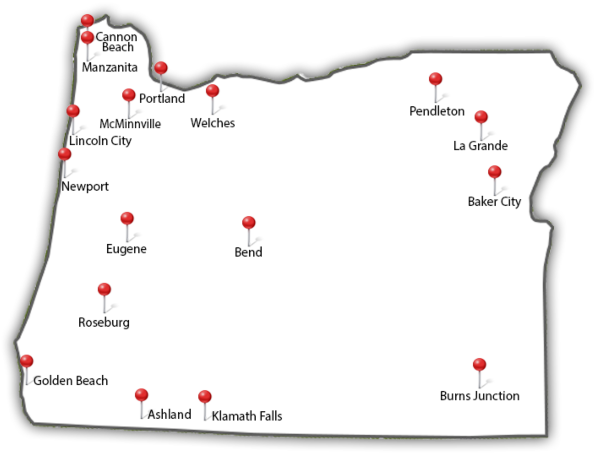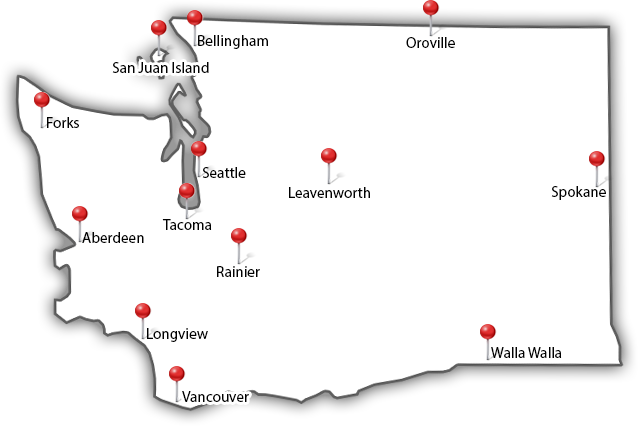Archive for the ‘Landscaping’ Category
Thursday, January 2nd, 2020

Trees are one of the most beautiful landscape elements out there. They look beautiful, create shade, and bring a sense of calm and relaxation to any outdoor area.
The only downside is that the area around the base of a tree is often tricky to accommodate. If you leave your tree to its own devices, it’s likely to suck up all the water in the soil around its roots. Plus, the shade from its branches makes it hard for plants underneath to get enough sunlight to grow.
This is no problem for the health of your tree, but a ring of bare dirt might not fit your landscaping vision! So how do you beautify the area around a tree without compromising its health?
Here’s what we recommend:
Don’t add or remove too much dirt
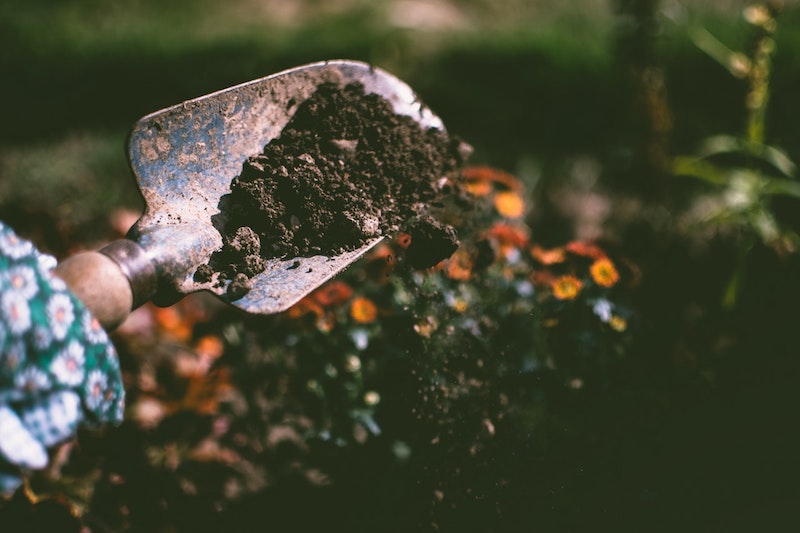
It’s important to maintain the level of soil around your tree’s trunk. Adding too much soil starves the roots of oxygen and can make the bark rot. In extreme cases, it can even slowly kill the tree.
If you need to add some soil, leave a ring of empty space (about 3-6 inches) between the trunk and the new soil. Then try to limit the amount of new soil you add to about 3 inches deep.
Choose the right plants near your tree
If you want to fill that empty-looking ring of dirt with plants, make sure you choose ones that can handle the conditions under your tree.
Evergreens are everywhere here in the Pacific Northwest, and many of them are thick enough to create a densely shaded area near the trunk where almost no sunlight gets through. To make things even more difficult, they also act like umbrellas, blocking rainwater from falling on plants near the trunk. Other trees, like maples, often do allow dappled sunlight through their branches, creating an area of filtered shade below.
Before choosing plants for under your tree, go outside on a sunny day and see how much sunlight comes through the branches. If it’s very shaded, look for plants that thrive in low-light conditions, like ferns and hostas.
When it comes to deciduous trees (which lose their leaves in autumn) consider flowers that bloom in the spring. These work well because deciduous trees let more sunlight through in the spring before they’ve fully leafed out for the summer.
Be careful with your tree’s roots and bark

Your tree’s bark is its protective barrier against disease and the elements. When you’re landscaping or gardening near trees, try not to nick or chip away at the bark (especially while weed whacking).
Look out for tree roots, too. Some trees have shallow roots hidden just beneath the earth so are extra easy to damage accidentally. Trees that are likely to have lots of shallow roots include:
- Willows
- Birches
- Beeches
- Maples
- Ashes
- Elms
Is it possible to plant near trees with shallow roots?
It’s OK to place other plants around these types of trees, as long as you choose shallow-rooted plants that will compete well with the tree. Do a little research about what plants coexist well with your specific tree, or ask us. We’re always available to answer your tree care questions! In the meantime, these are a few plants that often do well near shallow-rooted trees, like maples:
- Ferns
- Hostas
- Low-growing perennial plants that like shade
- Spring-blooming bulbs
During the process of planting, be on the lookout for shallow large or medium-sized roots. If you encounter one while digging a hole, simply refill the hole and move to a nearby spot.
A few more simple landscaping ideas
Try a raised flower bed
One tried and true way to create a beautiful display around your tree without damaging it is with a raised bed. Build your raised bed like a donut around your tree’s trunk, but leave a gap of at least 1-3 feet between the trunk and the bed’s inside wall. This is to avoid smothering the tree and damaging the roots.
Rocks don’t need sunlight!
There are many other ways to landscape around your trees without planting anything. Decorative garden accents require almost no upkeep and don’t need sunlight or water. Here are a few options:
- A decorative rock pattern
- A fairy garden
- Landscape lights (which also help you navigate your yard safely at night)

Consider replacing grass with native plants
If you love a more natural-looking yard and like the idea of a low-maintenance landscape, consider getting rid of your lawn and sticking to native plants. A more rustic landscape aesthetic works well with the earthy, uneven area around trees. Here are a few of the many benefits of a grass-free landscape:
- Helps you conserve water (especially in the summer)
- Requires less upkeep
- Supports your local ecosystem
- Makes it easy to preserve your trees’ health
Be extra careful with young trees
Does your landscape have trees that were planted less than 5 years ago? Keep in mind that young trees don’t yet have the defenses that older trees have, and even small plants will compete with them for water and nutrients.
Be extra careful when landscaping around these little trees. In fact, it’s best to avoid planting anything around them until they’re bigger and stronger. Instead, make sure you mulch them regularly and manually remove weeds that grow near the base.
Prune your tree regularly
Keeping your landscape beautiful and healthy involves a little maintenance, not just to the area around your tree, but also to the tree itself. Here are some benefits of proper tree pruning:
- Prevents branches from getting weighed down and falling on your lovely landscape — or even worse, your house!
- Encourages some sunlight and water to come through and nourish anything growing under the tree’s canopy
- Keeps your tree strong and healthy
- Improves the overall look of your landscape
Keep in mind that improper pruning can actually do more harm than good. A poor pruning job puts your tree at risk for diseases. In the worst cases, it can even destabilize the tree, putting your property at risk.
That’s why we always recommend hiring a professional arborist who has the tools and experience to prune safely. This also ensures you get an even, symmetrical result that improves the appearance of your landscape.

Need help with landscaping, pruning, or other tree care?
We’re here to help. Northwest Arbor-Culture offers complete tree care and landscape services in Portland, Vancouver, and surrounding areas.
Contact us to learn more or call us at (503) 538-8733 for a free estimate.
Tuesday, April 30th, 2019

They say money doesn’t grow on trees. While you won’t be plucking Benjamins from your branches anytime soon, planting trees on your property does add tremendous value to your home.
The financial benefit of trees goes beyond visual value (though that’s certainly part of it). There are other intrinsic and tangible benefits to Oregon homeowners of having healthy, beautiful trees on their property. Learn all about it!
1. Increased home resale value
Let’s start by breaking down the monetary impact healthy trees have on the resale value of your property.
- According to the Council of Tree and Landscapers Approval, a healthy and mature tree often has an appraised value between $1,000 and $10,000.
- The Arbor National Mortgage & American Forests reports that for homes listed for over $250,000, a healthy and mature tree can positively impact buyer interest by up to 98%.
- Specifically here in the PNW, a tree in front of the house can increase a home’s sales price by an average of $7,130.
- A Management Information Services study revealed that landscaping with healthy trees can increase property value by 20%.
- Spending just 5% of your home’s value on improving your landscaping—including adding trees—can have an ROI of as much as 150%.
2. Added beauty

Well-kept trees make a home look more attractive. It’s what’s known as curb appeal and it can make or break the overall look and style of your property.
The term curb appeal specifically refers to the way your home looks to someone standing on the street curb. While this is important for your own enjoyment and likability of your home, it’s even more important to a potential buyer.
3. Reduced noise & greater safety
Beyond just looking nice, trees offer some practical benefits. Trees offer protection from wind, rain, and most importantly, neighborhood noise. One study by North Carolina State University found that a strategically placed tree can block noise by as much as 40%!
Trees can also provide privacy for your family activities, either in place of or as a pleasant addition to a fence.
Surprisingly, houses with trees on the property also act a natural deterrent for crime and violence. Studies show that…
- Property crimes are less frequent when there are trees and more abundant vegetation around a house.
- Nearby trees and natural landscapes lead to 25% fewer acts of domestic aggression and violence.
- Trees in a public right-of-way are generally associated with a reduction in crime.
4. Greater foundational stability
A tree-lined property or even just one or two mature trees can work to strengthen the foundation of your property. Tree roots add stability to the soil around your house, keeping erosion in check.
They also help soak up excess moisture and stop run off and act as a pollutant filtration, which is particularly helpful for homes situated near slopes or riverbeds.
5. Amazing green energy benefits
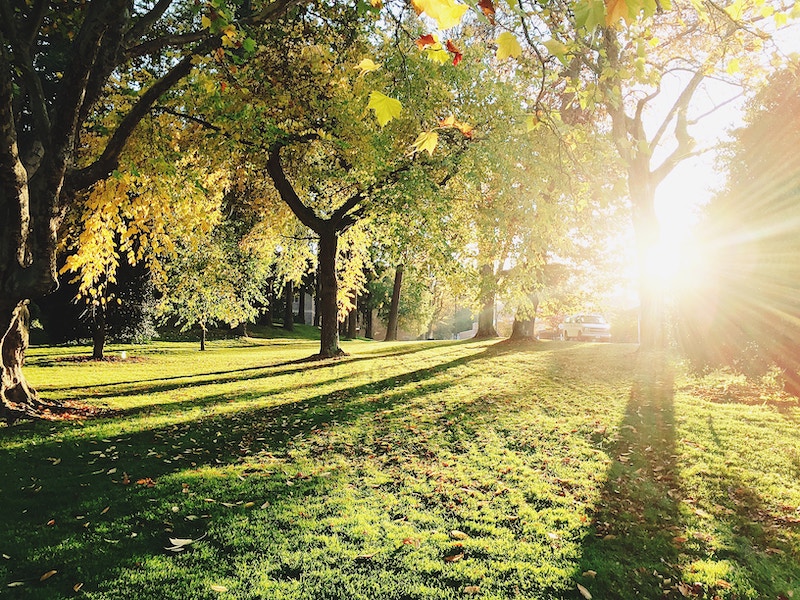
Trees around your property help conserve resources and benefit the environment.
First of all, trees absorb carbon dioxide and convert it into fresh oxygen. In fact, just 2 trees put out more oxygen than you’ll ever consume! And as we mentioned above, trees contribute to a healthy ecosystem by managing stormwater, pollutants, and conserving soil and water.
Trees can also help cut energy use in your home. According to the USDA Forest Service, trees can reduce the need for air conditioning by 30%. It can also save you 20-30% in heating costs!
The US Department of Energy suggests that just 3 properly placed trees can end up saving you a total of $100 to $250 every year in energy costs.
6. Increased wellbeing
Trees improve overall home life and enjoyability of your property. They provide shade and privacy for your outdoor parties or summer BBQs. They also provide a great playground for kids as a place to hang a tire swing, build a treehouse, or climb.
If you have fruit trees, they also provide a fresh snack to enjoy with your family or community. And overall, studies show that residents of homes surrounded by trees have a stronger sense of community and better relationships with their neighbors.
Does it matter what species of tree you plant?
Now that you’ve learned how beneficial trees are to the value of your home, you may be wondering if certain trees are better than others.
The answer is…not really! Other than fruit trees, which provide additional value if you harvest and eat the fruit or donate it through the Portland Fruit Tree Project, there aren’t any specific tree species proven to increase property value.
The key is to ensure the trees on your property are healthy and well cared for. And the older a tree, the better!
When trees can hurt the value of your property

There is one caveat to all the above…and that’s if you have unhealthy and damaged trees on your property.
You need to take care of your trees, and that means…
There may come a time when it makes more financial sense to remove a tree than keep it. Some signs that you need to talk to an arborist about tree removal are…
- The tree is hanging over your roof and causing damage (hopefully it just needs to be pruned)
- The tree is closer than 15 feet from your home (this may be a liability)
- The tree roots have gone wild and are now disrupting your foundation
- The tree is diseased or has a severe pest infestation
- The tree is dead
Have questions about the trees on your property? Ask an arborist!
When you have questions about the trees around your Oregon home, we want to be your first call. Our master gardeners and ISA-Certified Arborists are always ready to help.
Learn more about some of the most common tree question we hear, or reach out today!
Monday, June 18th, 2018

Are you considering trimming or pruning your trees yourself? Maybe you’re thinking “how can I save money on landscaping expenses?” Perhaps you’re even considering investing in tree trimming equipment and turning it into part of your home landscaping routine.
While it can be tempting to think tree maintenance can be a DIY project, the risks don’t outweigh the benefits. In this post, we’ll outline the reasons why it’s a good idea to hire a professional tree pruner.

Improper pruning can harm or even kill your tree
Improper pruning can actually damage your tree more than doing nothing at all. Since every tree and environment is different, it’s not as simple as researching and doing it yourself. Here in the Pacific Northwest, trees grow particularly fast. This underscores the importance of proper pruning, since things can spiral out of control quickly.
Common tree pruning mistakes include:
- Taking too much off the top: When you take too much off the top of a tree (known as “topping”), it no longer grows as it should. Not only will it lead to an ugly tree, but it will likely die due to a weakened branch structure.
- Not knowing where to cut: Many people approach pruning as simply cutting what looks like a weak branch. While removing dead branches is necessary, doing it improperly can severely damage the health of the tree. For instance, if bark is inadvertently removed the tree will be susceptible to disease. Also, if branches close to the trunk are removed it can hurt the tree’s ability to heal properly.
- Over pruning: Excessive pruning will kill your tree. At no point should more than 20% of a tree’s foliage be removed, as it will do irreversible harm.
Each tree (and tree species) is different
The primary reason it’s so hard to prune trees if you’re not an expert is the wide variance of needed maintenance from tree to tree. Two trees of the same species, even if they are right next to each other, can need completely different care.
The issue is compounded if they are different species. One species may need to be pruned in spring, while a different tree (even located in the same yard) may need to be pruned in the fall. Trees require unique care due to their genetic makeup and their reactions to a specific environment. For instance, two different species of trees react to rainstorms differently, meaning that the way severe weather impacts each tree could be very different.
Without knowledge, training, and experience it can be hard to know what to do.

Professionals will always have the training, experience, and equipment to get the job done
When you hire a professional tree pruner, you can rest easy knowing the job is done right. Local tree pruning services have worked with thousands of trees in the area and have a deep familiarity with local tree species.
They’ll also have experience with the type of tree growth and specific situations presented in your community. Plus, since they’ve seen so much tree growth in your community and know how to take care of Oregon trees, they won’t be phased by any challenges.
Arborists will always have the extensive amount of equipment needed to do the job right. They also will be trained to use the equipment properly and safely.
When you work with experienced and trusted Portland arborists you know the work is done by Accredited Certified Arborists who know how to do the job right the first time.
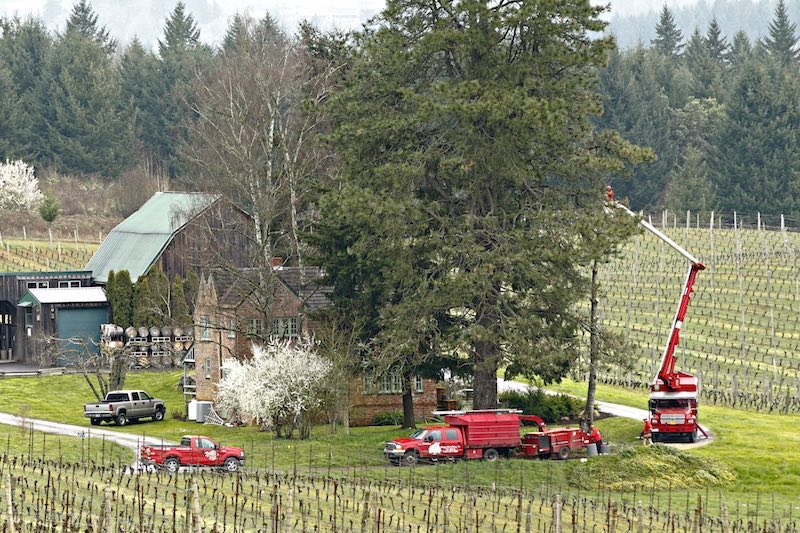
Work with Northwest Arbor-Culture
At Northwest Arbor-Culture, we’ve been helping homeowners here in the Pacific Northwest for 17 years. We know how trees in our community grow and are committed to ensuring the health and proper growth of your property’s trees.
We offer all the professional tree care services you’ll need.
Learn more about our tree pruning services.
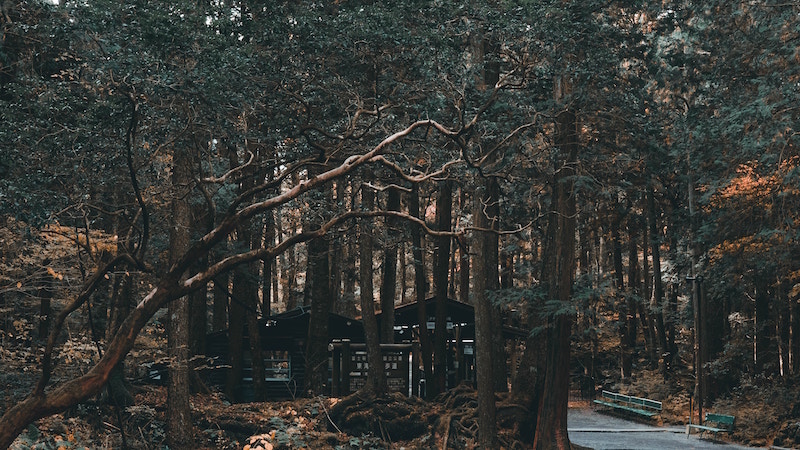
Tree pruning can be dangerous (to you and your home)
Between 2009 and 2015, 580 people died from injuries sustained while trimming trees. This is significantly more than other home improvement and maintenance projects.
There are a lot of reasons for this danger, including:
- It’s hard to tell a stable branch from an unstable one. Standing on or even knocking into one could make the branch collapse, either underneath or on top of you.
- When you’re up high anything can happen. With trees in the Portland area reaching heights over 100 feet, falls can be fatal.
- Wildlife often lives high up in trees and can become erratic when disturbed, either injuring you or forcing you to fall.
- For trees that are over or next to power lines, branches can fall onto the lines, knocking them down and creating an extremely dangerous situation.
While not as dire, trimming trees yourself can also cause severe property damage to you or your neighbor’s homes. Even if a branch is not over anything, when the branch falls it could be redirected by another branch, causing it to fall on your home or something else.
Trusted professionals will always have insurance
While not all property risks are alleviated by hiring professionals, a professional and experienced arborist will have insurance to cover any injury or damage. This will include any property damage caused by their work. It will also cover any injuries, serious or minor, inflicted on any workers while they are working on your home.
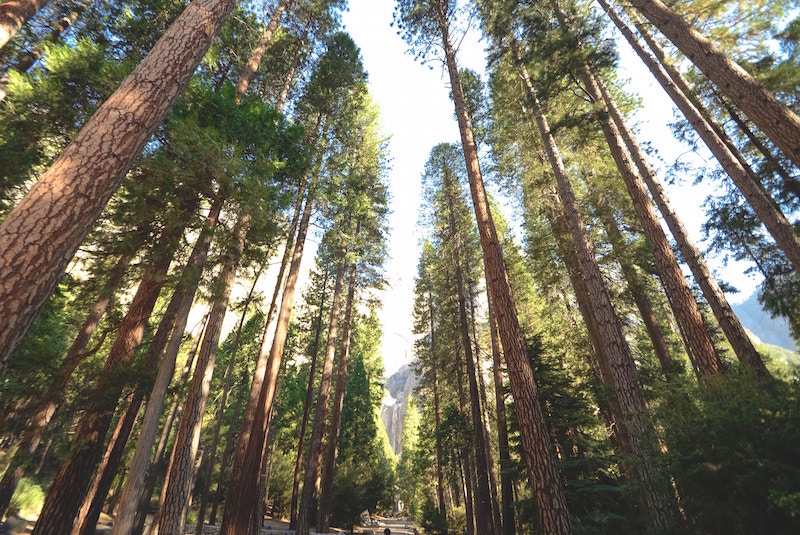
It will look better when you hire a professional
Tree arborists are professionals for a reason. They are there to make sure your trees are healthy and look great. When you trim trees yourself, the tree can grow at an angle that is both unhealthy and unattractive.
Landscaping is an investment in your home
If you’re like most people, your home is your largest asset and a large part of your financial future. Treat it as such and make sure to nurture it in a way that accentuates the things making it valuable.
Maintaining your home’s landscaping, and particularly trees, will ensure you protect the value of your home.
Money invested in landscaping generally has an ROI of over 150%!

Northwest Arbor-Culture can help protect your investment
Give us a call today to help ensure your home stays beautiful for the long haul. We have years of experience helping Portland homeowners keep their trees healthy and attractive. Call (503) 538-8733 or contact us online.
Friday, April 13th, 2018
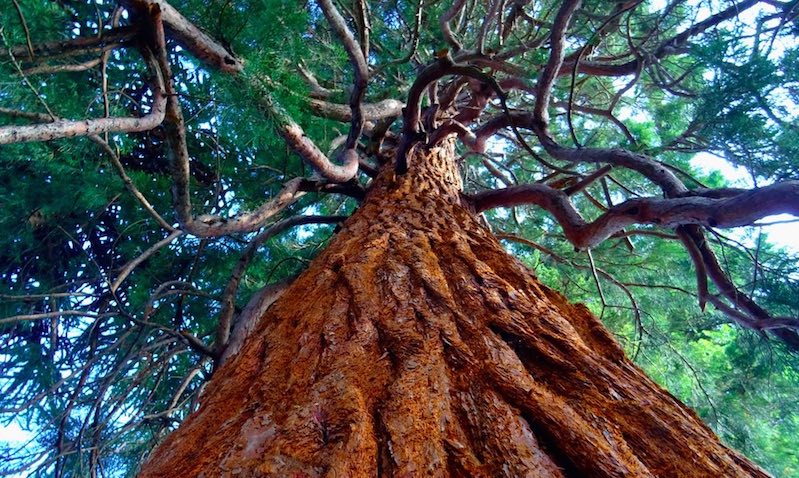
Do you have a small tree in your Portland yard? Maybe you had a fruit tree planted after moving into your new home, or you’ve had a few new trees planted to reduce erosion. Whatever the reason, if you have a young tree in your yard it needs a little TLC and special attention to thrive.
In today’s post, we’ll talk about how to care for a young tree in your Portland yard. We’ll also share the biggest mistakes homeowners make when caring for smaller trees.
Planning on planting? Read this first.
If you’re thinking about planting a young tree in your yard, there’s a lot to consider. Take a look at these recent articles written by our tree care experts to help you get started.
What comes next?
Once a tree is planted, proper care during the first 5 years of its life is critical. During this time, you need to monitor your young tree to make sure it’s:
- Getting enough (but not too much) water
- Safe from damage by bugs or weather
- Receiving the nutrients it needs and isn’t competing with other plants
- Pruned and trimmed regularly
Need help with a young tree? We’re here to help.
Read more about our tree services and meet our team of certified arborists and tree experts.
CONTACT US
Water
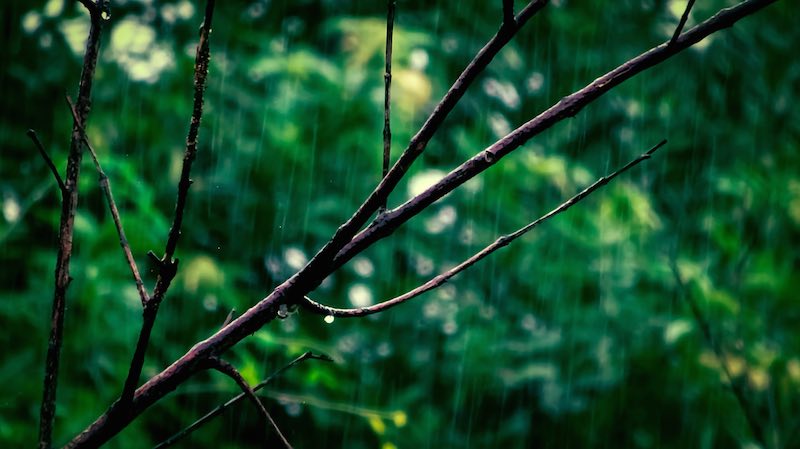
Is your tree getting enough water or too much? Either extreme can be harmful. Here’s what you need to know about watering young trees:
- Your sprinklers aren’t enough. Young trees need to develop deep roots for stability and long-term health. Lawn sprinklers don’t provide enough water and encourage the growth of roots near the surface. Depending on the time of year, you may need to supplement your tree’s water supply.
- Monitor soil moisture. The soil around your tree should be damp, but not sopping wet. Dig down about 6”. The amount of moisture at the very surface of the soil is less crucial.
- Add mulch. Mulching near a young tree (leave an open space of 6-8” from base of the trunk) can help conserve water.
- Water deeply. “Deep watering” young trees is the best way to deliver water where your trees need it most. Focus on watering slowly, allowing a smaller amount of water to soak deeply into the soil.
Winter, spring & fall
During the Portland area’s rainy months, your young trees will likely get enough water naturally. However, if it’s really rainy, watch out for standing puddles of water near the base of the tree. If you see puddles of standing water, get your trees inspected! There may also be drainage issues in your yard that need to be addressed.
This is the most common sign of a tree that’s getting too much water!
Summer
Most summers, the Portland area is very dry and your tree will need extra water. Be on the lookout for these signs your tree isn’t getting enough water:
- Yellowed or curling leaves
- Leaves that drop before fall
- Soil that’s extremely dry and dusty
Weeds, plants, pests, and people
Don’t overlook other threats to your trees! Young trees don’t have the same defenses as mature trees and are more susceptible to damage from a variety of sources.
It’s very important to keep weeds away from the base of younger trees. Plants (even grass from your lawn) will compete with your tree for nutrients and water. Keeping the area around your tree clear of any weeds or plants is crucial for a healthy young tree.
Manual weeding and mulching are the best ways to keep weeds and plants from encroaching on a growing tree. Avoid the use of herbicides or pesticides as these can contain toxins that’ll damage a young tree.
Pests can be especially damaging to smaller trees. Infestations can take hold easier and do more damage. Watch for signs of insects like aphids, beetles, and ants so you can take action before it’s too late!
People are a big threat to growing trees, too! Maturing trees have softer bark and are more susceptible to damage from lawn mowers and weed eaters. Even a little damage to the bark of a young tree can hurt its ability to grow and remain healthy.
Weather
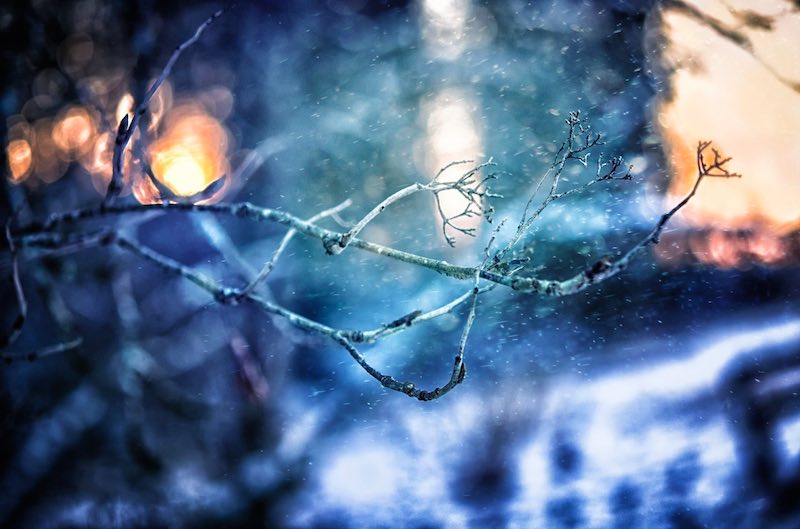
Strong winds are especially dangerous to young trees. Their root systems are not fully developed and they may be more likely to fall or be pulled out of the ground during winter storms. Newly planted trees are also more likely to be damaged by frost and ice than older more established trees.
But believe it or not, ice can actually protect younger, smaller trees. During shorter cold spells, ice can act like a blanket, insulating the tree’s branches from colder ambient temperatures.
Sunscald
Sunscald happens during colder months when tree bark gets hot from the sun, and then rapidly freezes at night.
To prevent it:
- Wrap the trunk with a tree wrap or plastic tree guard
- Keep the wrap on the tree until early spring
- If your tree experiences sunscald damage (which appears as elongated, sunken, dried or cracked areas of bark), cut back the dead bark until you reach live tissue
Staking
During very windy weather, young trees with flexible trunks may benefit from staking. But don’t stake it too tightly. Your tree should still be able to sway freely without bending so far that it might pull out of the ground.
When to start trimming & pruning
Young trees need to be pruned! It helps them to build a strong structure. If you wait too long to prune your trees, branches may become too heavy and deform the tree. When our tree experts prune and trim young trees, we focus on removing:
- Dead, diseased, or damaged branches
- Lower branches encouraging growth of the crown
- Crossing branches
- Multiple leaders, especially on evergreens
DON’T FORGET: If an older tree’s canopy is covering a newly planted tree it must be trimmed back. Young trees need plenty of sunlight to grow.
Questions about your young trees?
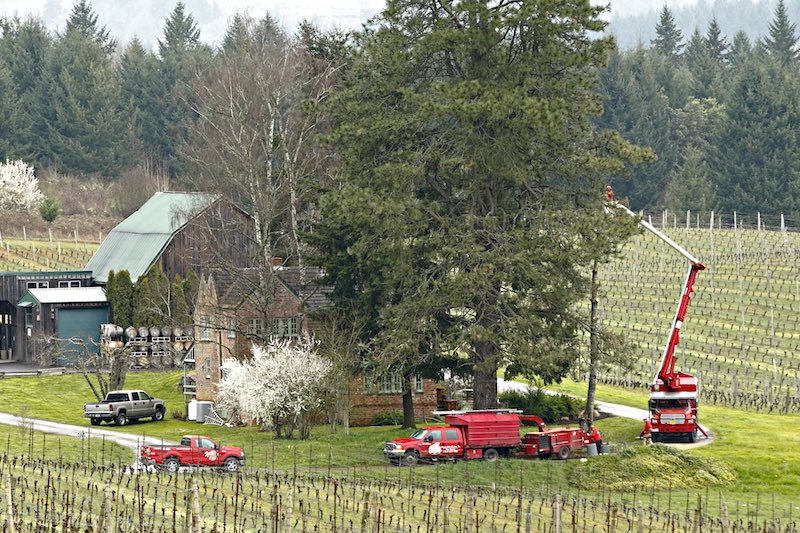
If you have young trees in your yard, we’d love to come out and take a look. Our certified arborists and tree experts can inspect your trees and suggest a pruning plan. We can also remove older trees and even help with the landscaping of your yard.
Call us today at (503) 538-8733 to learn more.
Wednesday, January 17th, 2018
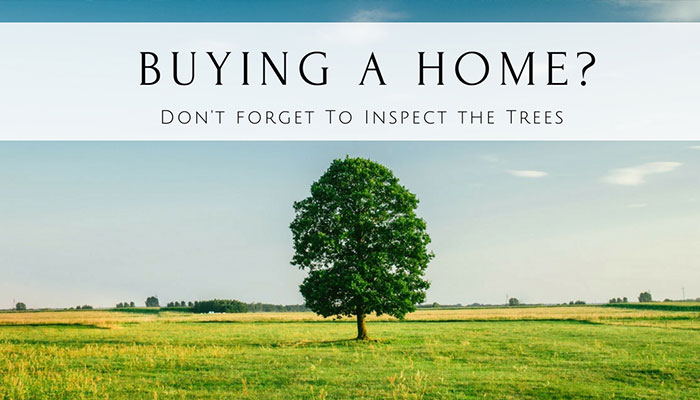
Shrewd house hunters always await a professional inspection before purchasing a home. Too often, though, homebuyers completely neglect to inspect the trees surrounding the house and property.
It’s always a good idea to hire an ISA Certified Arborist before buying a house. A yard may require extensive tree maintenance or have other tree issues you’ll need to take care of. Partnering with an Oregon and Washington arborist will help you avoid unexpected surprises down the road.
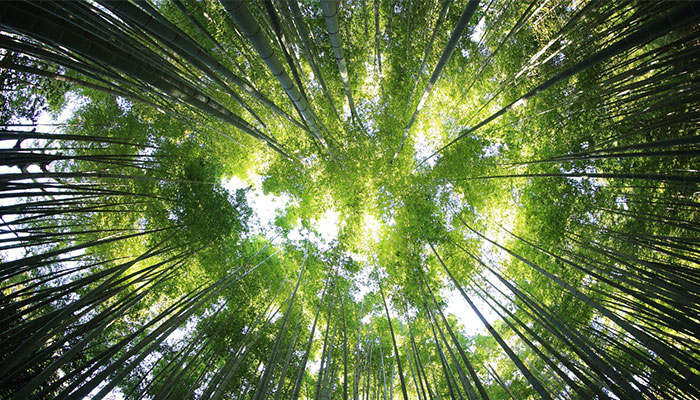
Why Inspect Your Trees?
Inspecting the trees in a yard before purchasing a house ensures the property aligns with all local landscaping regulations. A professional and certified Washington and Oregon arborist knows what to look for and will help ensure you make a fully informed decision.
Beyond regulations, the most important reason for a pre-purchase home and property tree inspection is safety. Problematic trees pose a great risk of damaging your property or endangering your family.

Tree Issues to Watch for When Purchasing a Home
Your realtor or home inspector may not understand how to spot signs of a problematic tree. An ISA Certified Arborist, on the other hand, will know exactly what to look for. They will ensure you are fully informed as you make the big decision to buy a home in Oregon or Washington.
Here are a few of the things an ISA Certified Arborist will look for when inspecting a house and property.
Tree Species
Beyond potential tree dangers or issues, it’s smart to know the species of trees you’ll be dealing with. Here in Washington and Oregon, there are over 60 native tree species alone!
Arborists will begin by determining the type of trees on the property. Then, they’ll educate you on what to expect, including:
- Seasonal characteristics of the trees
- Maintenance requirements
- Common issues
Whether or not you have any interest in trees, knowing the species surrounding your property is very important for maintaining your new house and yard.
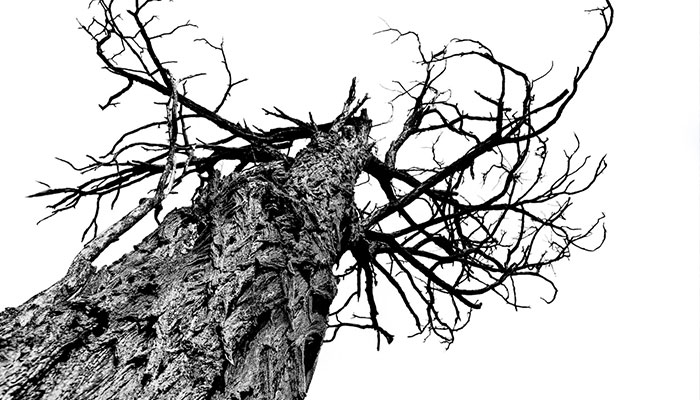
Dead, Dying, or Diseased Trees
Dead, dying, or diseased trees on your property don’t just look bad, they are also a huge inconvenience and potentially catastrophic. Dead or dying trees attract pests and can fall without warning. Diseased or pest infected trees can spread to other trees around your property.
A dead or dying tree on your property can’t fix itself. It will be your job as the new homeowner to take care of the issue. This can be an expensive undertaking, especially if it’s a large tree and requires removal.
There are 3 tell-tale signs an Arborist will look for to determine the health of your tree:
- Trunk Damage: As a tree ages, old bark will fall off and grow a new layer. A tree without bark can be an indication of failing health. An Arborist will also look for vertical cracks and damage along the tree trunk.
- Fungus: Fungus along the trunk or branches of a tree may indicate internal rot. A rotting tree means it’s either dying or already dead.
- Damaged Roots: Some signals an Arborist will look for are small branches popping up from the base of the tree trunk. This is known as epicormic shoots and means the tree is under extreme stress. Another sign of damaged roots can be a tree leaning to one side.
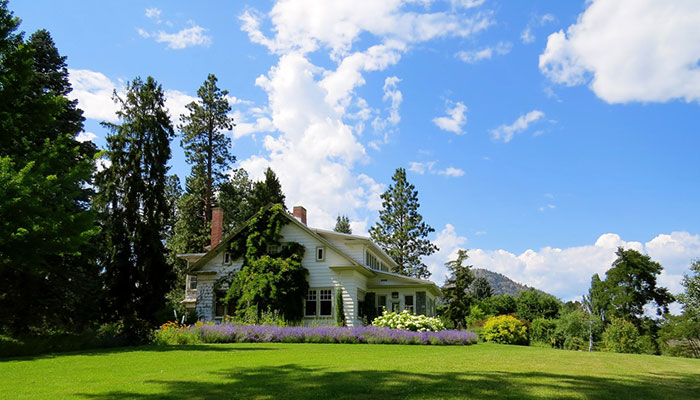
Trees Too Close to the House
At a glance, a big maple tree in the front yard adds character to the property. But if the tree isn’t sturdy, there’s a chance it could come crashing down on your house during a storm. A tree decades old can have hidden problems that the current owner isn’t aware of.
Even if the tree is sturdy and safe, an Arborist can analyze the amount of yearly maintenance will be required.
Here some questions an Arborist can help you answer:
- Will regular pruning be required?
- Will you be dealing with an abundance of leaves to clean during the fall?
- Is the tree close enough to drop branches or debris into your gutter?
- Does the tree have nuts or fruit you’ll need to take care of?
A tree may not be very close to your house, but if it’s big enough, its branches may pose an issue. Unruly tree branches can fall on your roof or car, crash through windows, or deposit debris around your yard.
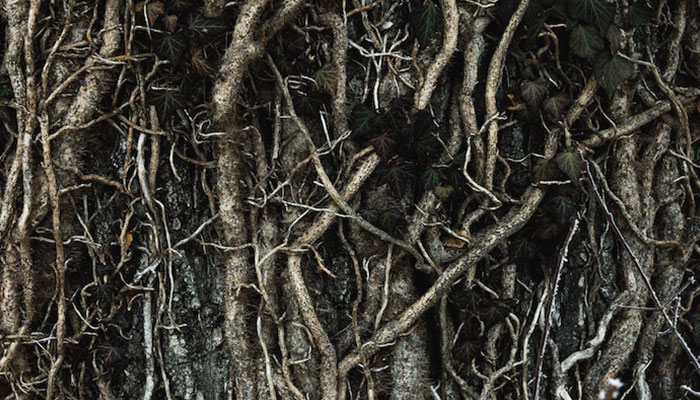
Roots Disturbing the House Foundation
A beautiful tree in your yard could be causing a significant threat to the foundation of your home.
Roots grow in search of water and nutrients. Depending on the type of soil surrounding your house, this can cause structural damage to your property.
For instance, if your house sits on compact clay soil, roots pushing their way though can affect the placement of this soil. This can cause your foundation to shift and crack.
Another type of soil that is easily damaged by roots is loose dirt and rock. This material will easily shift and become displaced as roots move through.
ISA Certified Arborists can get a read on the type of soil around your property. They will give you an idea of how roots are affecting your foundation, or how they may cause problems down the road.
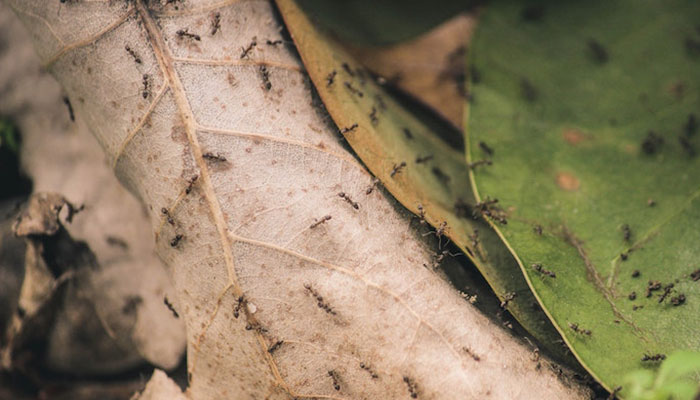
Problematic Tree Pests
Perhaps the most annoying tree issue to be aware of is a pest infestation. Depending on the Pacific Northwest area you live in, there are certain tree pests to be aware of. An Arborist will tell you exactly what type of insects to watch out for and whether or not a tree is currently infected.
A pest-infected tree can pose many problems. Some bugs can chew through the wood and bark of your tree, making it unsound and unsafe. Others will eat away at your tree, slowly killing it. If you’re dealing with a serious infestation, it’s possible the bugs have spread to other trees on the property.
Beyond insects and pests, it’s also smart to be aware of other critters than may be living in your trees. From squirrels and raccoons to bees, owls, and other birds.

What If the Tree Inspection Reveals a Problem?
A tree issue on the property doesn’t always mean you shouldn’t purchase the house. But it should play a role in your decision. If the house or property has a severe tree issue, it could cost you hundreds (and even thousands) of dollars. You may be able to negotiate a lower price on the home or have the seller pay for the cost of maintenance.
If you’re looking at a home in the Oregon or Washington area, contact us. We’ll ensure you’re getting the best deal for your money and eliminate unwanted surprises by conducting a pre-purchase home and property tree inspection. Our ISA Certified Arborists are happy to help you.
Monday, December 5th, 2016
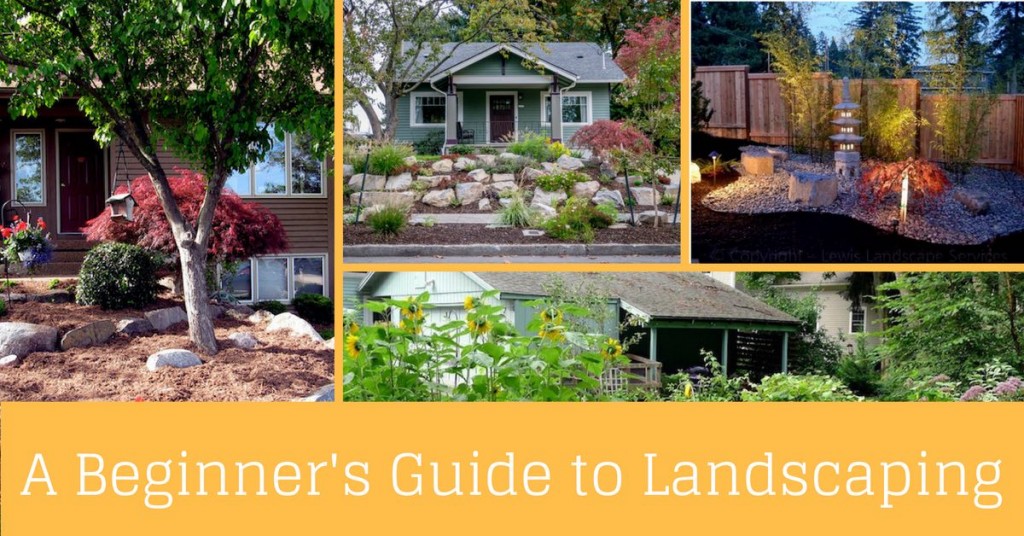
Do you own a home in the Portland area? Are you looking for a fun DIY project? Have you wanted to make your yard look nicer but don’t know where to start?
In today’s post, we’ll tell you everything you need to know about landscaping in Portland. You’ll learn how to plan a successful project and what you’ll need to know before starting. We’ll also share some of the best resources for learning about landscaping in Portland.
Let’s Get Started!
Landscaping is Like Remodeling… For Your Yard
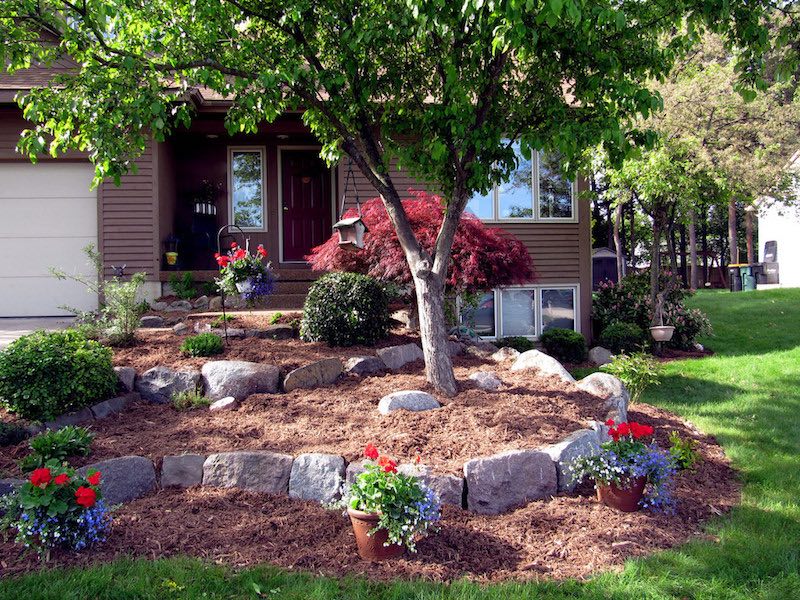
Like remodeling, landscaping can have a variety of purposes, from aesthetic (think painting your living room walls a new color) to functional (like replacing a leaky roof). However, the best landscaping and remodeling projects offer both aesthetic and functional benefits. Examples include:
- Planting trees to prevent erosion
- Starting a garden
- Removing trees that might fall and damage your home
- Adding a flower garden
- Designing a rock pathway to keep you from stepping in muddy grass during the wet winter months
What Are Your Goals?
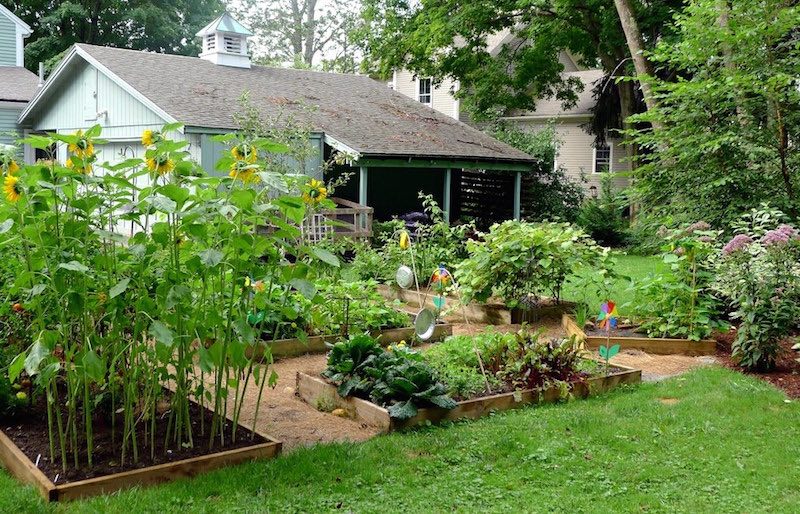
No matter what type of landscaping project you’re interested in, the key to success is defining your goals before you start. Don’t just wing it! When it comes to landscaping in Portland, you need to have a clear idea of what you want to accomplish before you begin planning. Otherwise, you’ll end up frustrated and spending too much money on a project you don’t love.
Our #1 Tip: Start Small
It’s fun to dream big about transforming your yard into an amazing paradise. But it’s just not realistic. When planning your first landscaping project, it’s best to start small. Think about smaller projects that can be part of your bigger overall goal for your yard. By starting smaller, simpler projects you can actually finish, you’ll be able to see (and enjoy) your progress and will be more motivated to keep working on more projects!
Research, Plan, & Budget
Before breaking ground on any Portland landscaping project, you need to research, plan, and create a budget. Otherwise it’s easy for a seemingly simple landscaping project to turn into a total nightmare!
There are some great online tools to help you with your planning, like:
Portland Landscaping Project Ideas
Not sure where to start? Here are a few projects that anyone can do with a bit of planning and hard work!
Build a Garden With Raised Beds
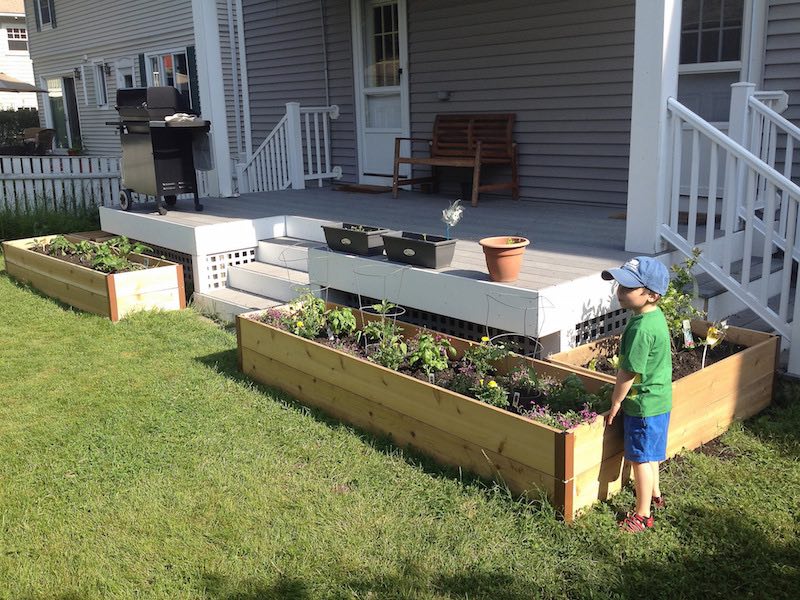
Does your family love fresh veggies? No matter how big or small your yard is, you can build a set of raised beds and grow a variety of healthy vegetables. Plus you’ll get to enjoy them all year round! It’s an awesome first landscaping project. Here are a few links to help you get started:
Install a Rainwater Collection System
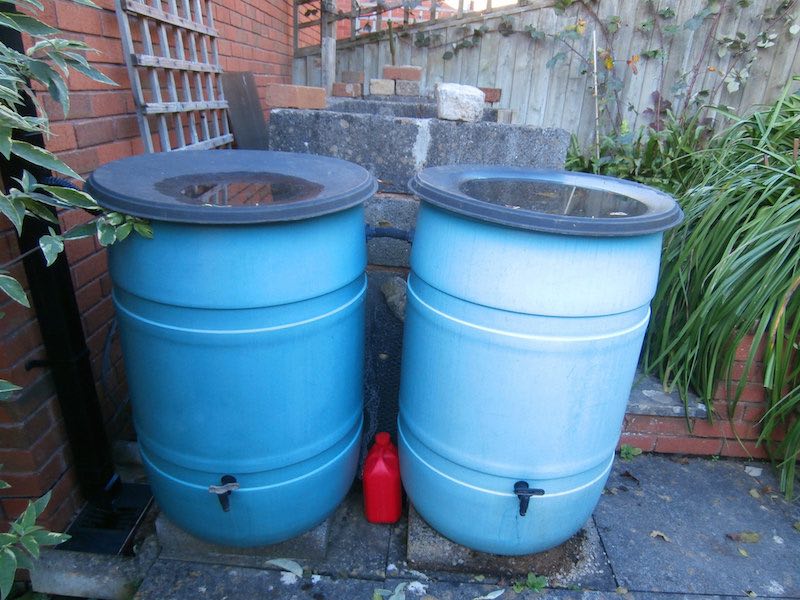
Here in Portland, we get nearly 40” of rain every year! If the water in your yard doesn’t drain properly, it can damage tree roots, your lawn, your plants, and even your home itself. A great DIY project is to install a rainwater harvesting system to store rainwater for later use. You can use harvested rainwater for irrigation, outdoor cleaning, and more. Here’s how to do it:
Replace Your Lawn With Natural Plants
When it comes to landscaping in Portland, natural, native plants tend to be easier to care for and better for your yard. Ferns, evergreens, fruit trees, and other native plants require less water and care (because they’re adapted to our climate) and are better for the environment. If you’re tired of babying your lawn, think about going all natural!
Local Landscaping Projects
Do you need some inspiration to help you get excited about landscaping in Portland? Here are some amazing projects we’ve found to inspire you!
Amazing Outdoor Fountain
Natural Rock Retaining Wall
Japanese Zen Garden
The Best Resources For Landscaping in Portland
Are you’re planning to start landscaping in Portland, there are plenty of awesome local resources for supplies, including:
- Portland Nursery – A great overall landscaping resource guide.
- City of Portland – Everything you need to know about landscaping in Portland, including laws, tips, and much more!
- Portland Tool Library – Don’t buy tools you don’t need! Borrow them from this amazing non-profit.
Are You Ready to Start Landscaping in Portland
Before you start on any landscaping project, consider the impact it might have on the trees in your yard. If you have questions, contact us today! Our certified arborists will come out and offer you their advice– free of charge.
Photo Credits: Jennifer C., Rachel Kramer, Lori L. Stalteri, Juhan Sonin
Tuesday, May 31st, 2016
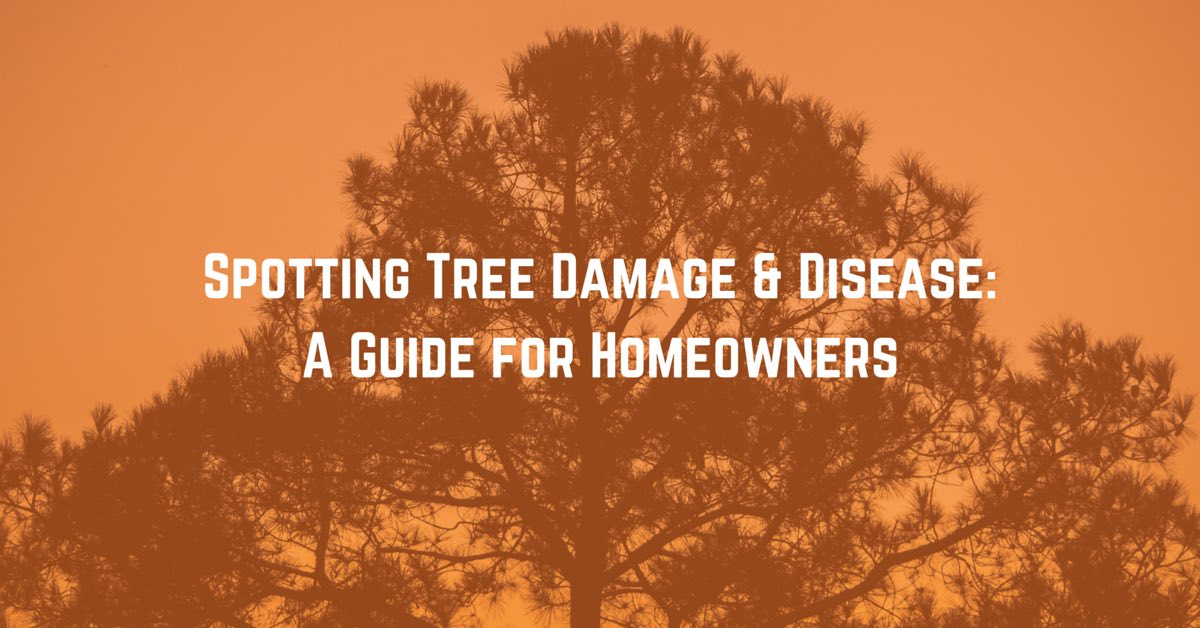
Did you know that there are some trees that can live to be over 5,000 years old? While the trees in your yard won’t live that long, if they’re well maintained, they can live for 50 years or even longer! Unfortunately, many trees become diseased, rotted, or damaged before they can reach their full potential.
Today we’ll talk about some of the most common causes of tree problems and diseases as well as signs that your tree might be unhealthy and in need of help.
Weather & Storms
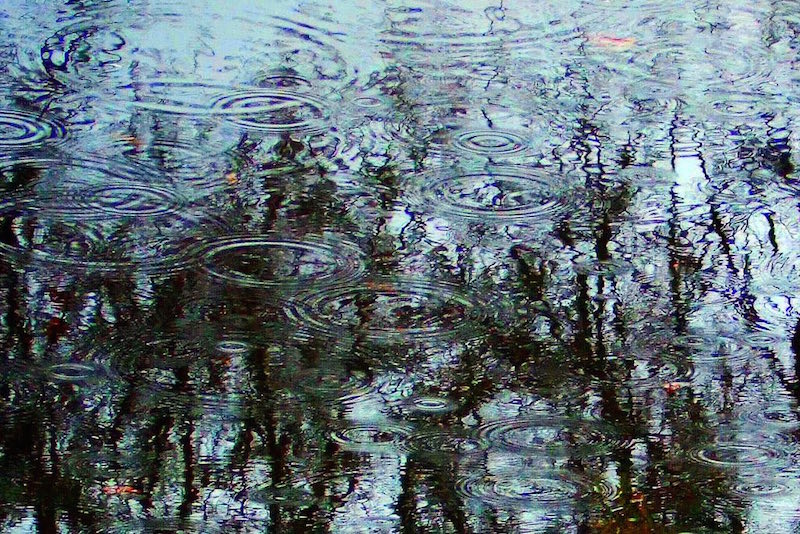
Our Portland climate is generally pretty mild, but our weather can still cause serious damage to trees. During the rainy months, too much precipitation can cause the ground to become waterlogged, loosening a tree’s roots. This can cause trees to lean or even topple over! During the winter, ice and snow accumulation can put stress on branches and cause them to break off
Root Damage & Loss

Tree roots are like an anchor, holding the tree steady and straight. They also absorb water and nutrients from the soil. Without a healthy root system a tree simply can’t be healthy. Since they’re underground root problems are often difficult to spot until damage has already been done. Roots can be:
- Cut or crushed by heavy construction equipment
- Infected by invasive fungus
- Damaged by lack of available nutrients or changes in the environment
Disease & Infection

Diseases and infections from fungi, bacteria and other sources can be deadly. In the Portland area, for example, elm trees are especially susceptible to Dutch Elm disease. Dutch Elm disease is caused by a fungus that’s carried by certain types of beetles. The disease can spread quickly and kill many trees if it’s not caught early. Other common tree diseases include:
- Anthracnose – A fungal infection that attacks leaves, flowers, and fruits. You’ll often see this on dogwood trees.
- Dothistroma – Another fungal infection that can kill younger pine trees. This infection causes a pine tree’s needles to fall off, preventing the tree from creating the energy it needs to grow.
- Leaf Blight – Actually a variety of related ailments, leaf blight can damage a tree’s canopy, over time weakening and killing the entire tree.
Age
In a way, trees are just like people. As they age, they become more susceptible to some diseases and ailments. The branches of older trees may weaken due to an accumulation of small cracks and breaks. Depending on the weather, older trees may dry out and become brittle and unhealthy.
Construction
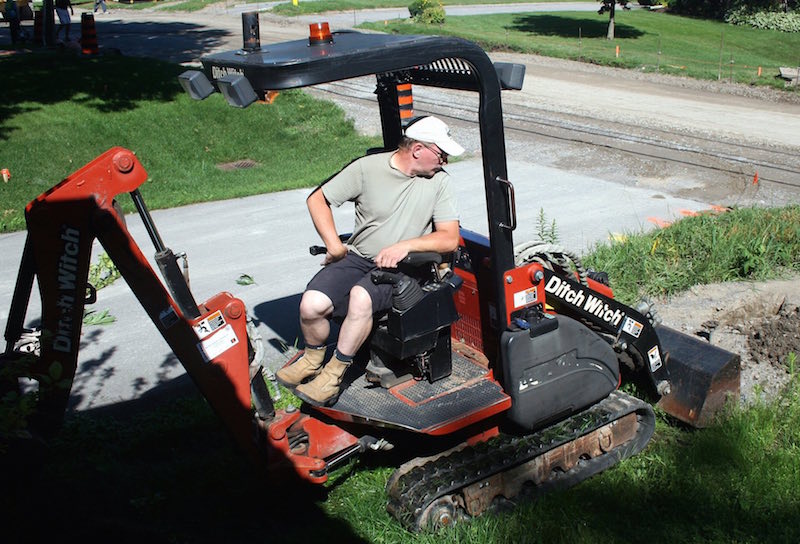
Heavy construction machinery can compress soil and damage a tree’s root system. It’s important to remember that a tree’s roots extend far from its base (in some cases 30 feet or more), making it important to stay well away from trees during construction. In addition, careless use of construction equipment can rip off a tree’s leaves and branches or cause damage to the trunk itself.
So be careful when you’re doing any work in your yard!
Poor Maintenance
Trees need our help to stay healthy! If you don’t take good care of your trees, they’re more likely to suffer from disease, damage, and other common tree problems. Luckily, most trees don’t require much maintenance. They only require regular trimmings and inspections to make sure the bark, roots, branches, and trunk are healthy and stable.
What To Look Out For
While some tree problems are tough to spot, there are some telltale signs you can be on the lookout for.
Sudden Changes to Leaf Color & Density
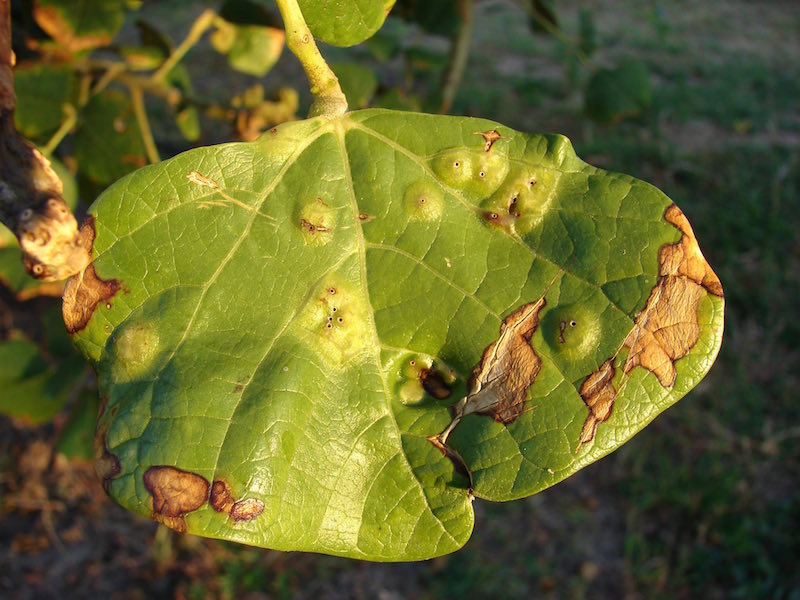
If a tree’s leaves suddenly change from green to yellow, or if leaves become splotchy or have a “banded” appearance, that could be a sign of fungal infection or disease. Or if a tree’s leaves or needles begin to fall off out of season, that’s another warning sign.
Unusual Growths & Knots
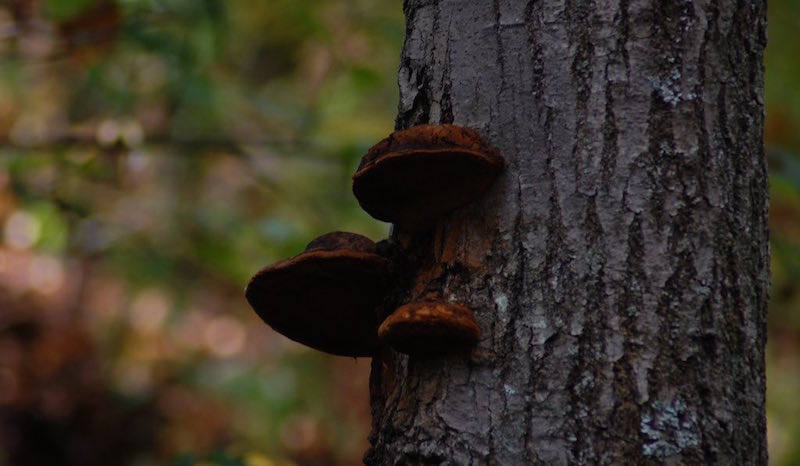
Bulbous growths or swollen areas in a tree’s trunk can be caused by bacteria growth. Fungus growing from a tree’s trunk or branches can also be signs of an unhealthy tree. These growths are often signs that your tree isn’t getting the nutrients it needs to grow normally.
Insect Damage
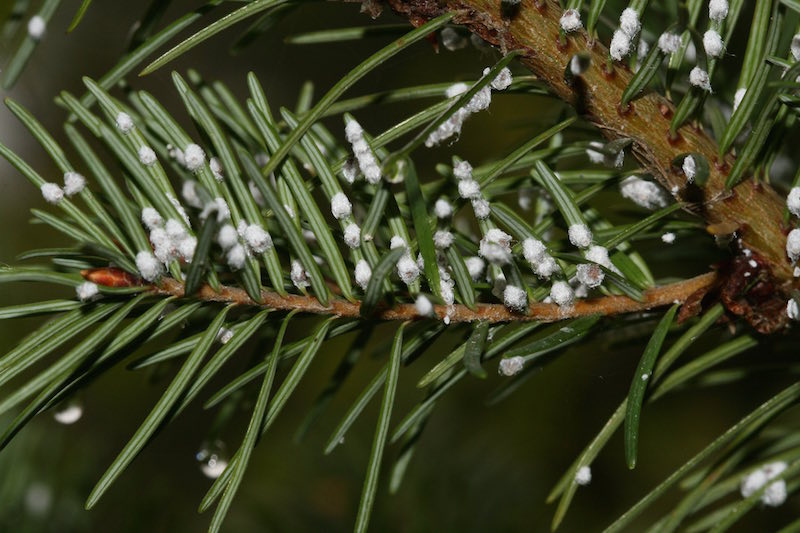
Insects can do real damage to the trees growing in your yard. Most of the time, it’s easy to spot insect damage because you can see insects crawling, flying, and buzzing around your tree, and most of the damage done will be to the tree’s exterior. Here’s what you should be on the lookout for:
- Leaves that look “chewed” or bitten – Beetles and some caterpillars feed on tree leaves. Too much damage to too many leaves can prevent your trees from getting the sunlight and nutrients they need.
- Leaves with unusual colors – Aphids, leaf hoppers, and other insects can damage leaves, causing them to turn yellow or develop a “speckled” appearance.
- Moldy bark – Aphids, lacebugs, and other insects excrete substances that can cause mold to grow on your trees, potentially causing long term damage.
Protect Your Investment
There are just so many benefits to having trees in your yard: they’re beautiful, can make you happier, and even make your property more valuable!
You should think of your trees as an investment that needs your attention to keep paying off. With just a bit of care and attention, you’ll be able to enjoy your trees for decades to come!
Ask a Professional
If you’re seeing evidence of these common tree problems and diseases, don’t worry. And if you’re at all worried about the health of your trees, don’t worry.
Contact NW Arbor Culture online or call us at (503) 538-8733 for a free consultation and estimation. We’re happy to come out, take a look at your trees, and let you know our expert opinion. We have over 30 years of experience caring for trees in the Portland area and know how to make sure your tree lives a long, healthy life.
Photo Credit: K. Kendall, Ash Kyd, John S. Quarterman, Robert Taylor, S. Rae, Carolyn Tiry, Forest & Kim Starr, AJ Cann
Tuesday, January 12th, 2016

Last month, I showed you the best trees to plant if you live in the Portland area. Today, I’ll tell you why planting trees is so important and how you and your community can benefit! For example, did you know that planting trees can actually make you healthier? Believe it or not, it’s true!
But that’s not the only benefit of planting trees in your yard. Keep reading to find out 6 more great reasons to plant trees in Portland.
Because Trees Are Beautiful!
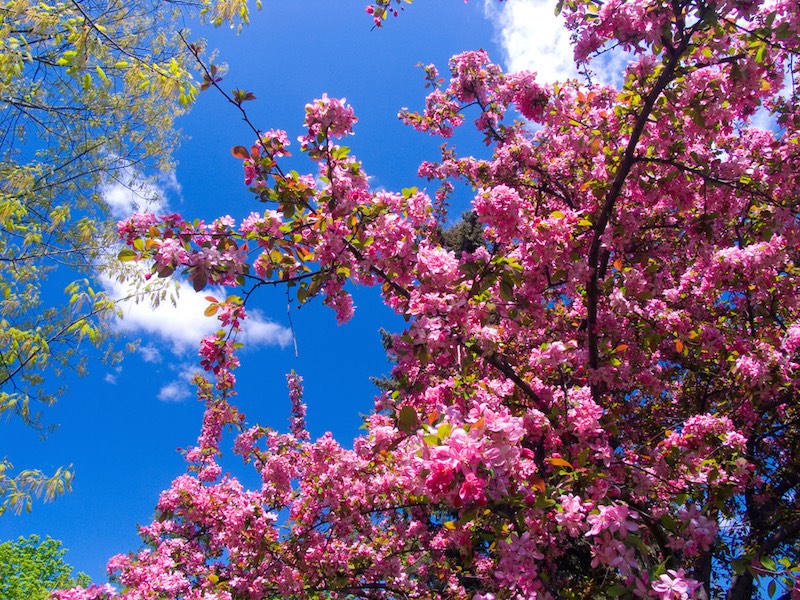
Trees are like one-of-a-kind works of art that you can help create.
No two trees are alike. Some are tall and thin, others short and full of leafy branches. Some turn gorgeous vibrant colors in the fall, others are a beautiful green all year round, and some even bloom beautiful flowers in the spring!
Trees are full of interesting shapes, textures, and even sounds! There’s really nothing else like them.
If you plant a tree in your yard, you’ll get to pick exactly what you’d like to see, and you’ll be able to enjoy it for years to come.
For Your Health
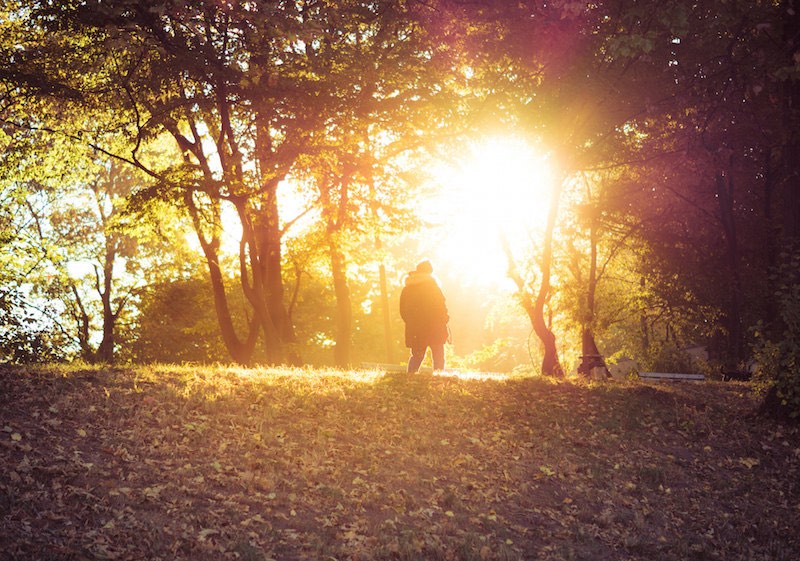
I mentioned this surprising fact in the beginning of today’s post, and I’ll say it again now: trees have actually been proven to improve people’s health and well-being.
People who live in areas with more trees tend to have lower blood-pressure and have improved overall psychological and emotional health. Kathleen Wolf, a researcher at the University of Washington in Seattle, even says that people with ADHD are calmer and more relaxed when they live near trees!
Helping the Environment
Remove Pollution
Unfortunately even green, eco-conscious areas like the Pacific Northwest suffer from air pollution. Sulfur dioxide, ozone, nitrogen oxides, and other chemicals are all released from cars, trucks, and other sources of pollution.
Believe it or not, trees can actually catch and prevent these pollutants from making their way into your lungs! This can help reduce the symptoms of asthma and other respiratory illnesses.
If you’re an allergy sufferer, there’s good news for you, too! The Portland area and surrounding Willamette Valley frequently have the highest pollen counts in the country. Luckily, in addition to absorbing man-made pollutants, large, leafy trees can keep pollen, dust, and other natural allergens out of your home and out of your nose and lungs! You’ll breathe easier with trees in your yard!
Provide Home to Local Wildlife
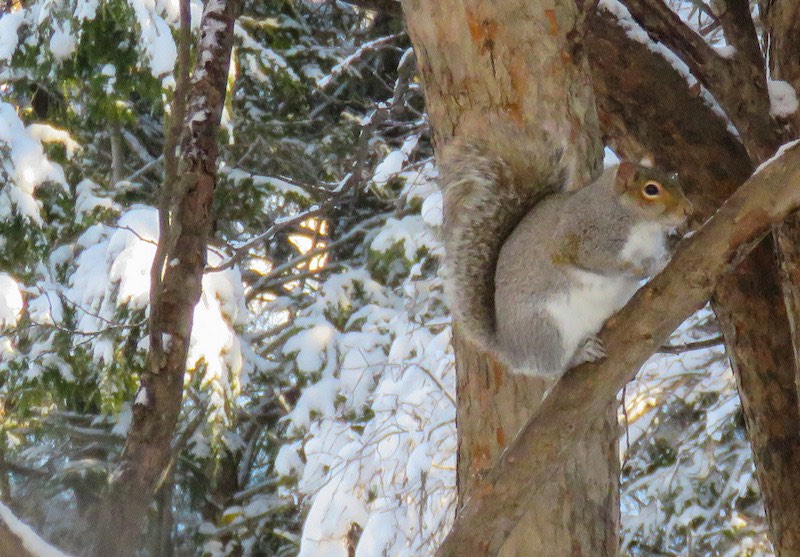
In addition to helping you feel better, there are other environmental reasons to plant trees in Portland. Trees make great homes for birds, squirrels, and other animals. Trees also provide a food source for these animals in the forms of nuts, fruits, and insects that call the trees home, too.
Birds and insects that nest in trees can also help pollinate nearby flowers and plants. This helps to build a natural, healthy ecosystem for all plants and animals in the area! By planting a tree, you’re doing your part to preserve our natural plants and wildlife.
Conserve Water & Minimize Erosion
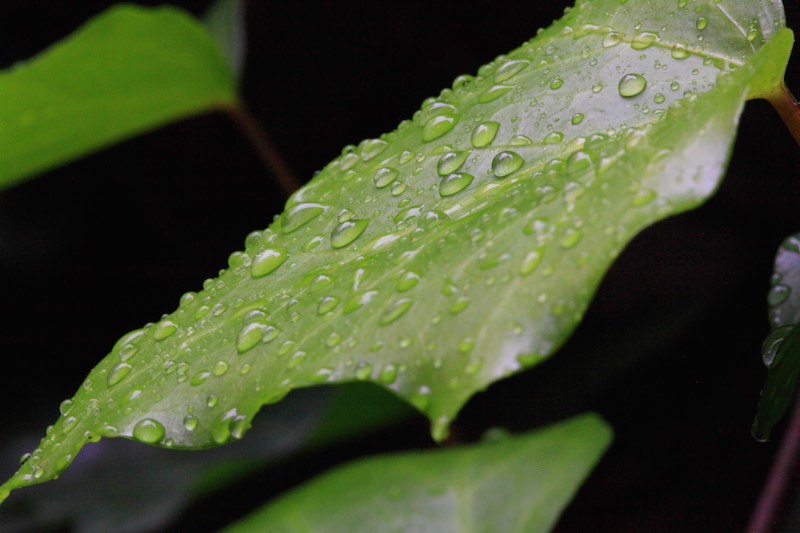
Did you know that 100 trees can catch 250,000 gallons of water every year?
Without trees and their complex system of sponge-like roots, rainwater soaks directly into the ground, causing erosion, and potentially dangerous landslides. Trees and their roots soak up rain, and release it slowly, minimizing the risk of damaging erosion.
Provide Privacy
When you live in a city like Portland, or even in a densely populated suburb, it can be hard to find a quiet, private place to call your own– even in your own yard! That’s where trees can help. Their branches, leaves, and trunks can make your yard and home feel more private. They block out city noise and traffic sounds, and keep nosy neighbors at bay, too!
In the Portland area, trees like holly, bamboo, and cedars are great trees to plant for privacy. They grow quickly and densely and don’t require much maintenance. They also have a small footprint, meaning they grow straight up, don’t spread out too much, and stay right where you want them to grow!
Conserve Energy & Save Money
Many Portland-area homes don’t have air-conditioning. We’ve had some real hot days these past few summers and it can be hard to keep cool!
Once again, trees to the rescue! Shade trees like maples and dogwoods have large leafy branches that absorb sunlight and heat, reducing heat gains by up to 80%! This keeps your house cooler and can reduce your cooling bill, if you do have air conditioning!
Increase Your Property Value
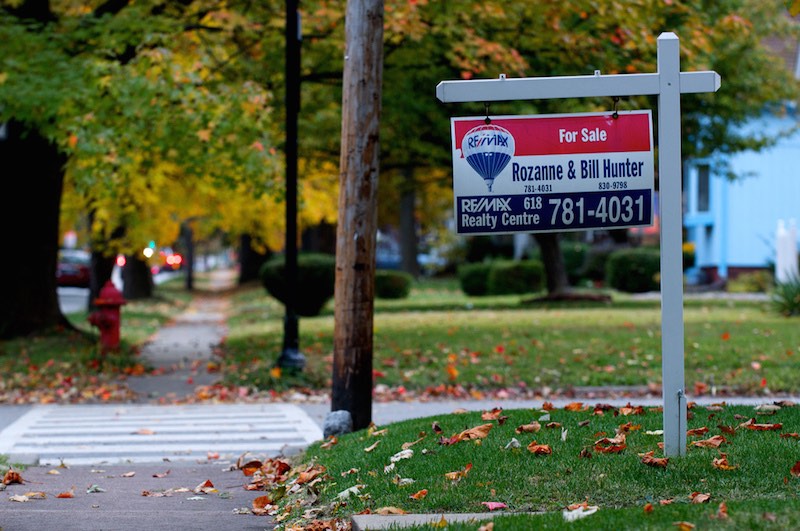
According to a recent study, homes with well-maintained yards and trees tend to sell faster and fetch a higher price! One thing to keep in mind, however, is that the study focused on yards with mature trees. That means you should start landscaping and planting trees now, because it might take several years for a young tree to mature.
Why do trees improve property value? It’s not entirely clear, but experts think it’s a combination of all the benefits trees provide, from privacy to beauty and everything else in between. Even if home buyers don’t realize it, subconsciously they’re attracted to homes with beautiful trees and they’re willing to pay for it!
Build Community
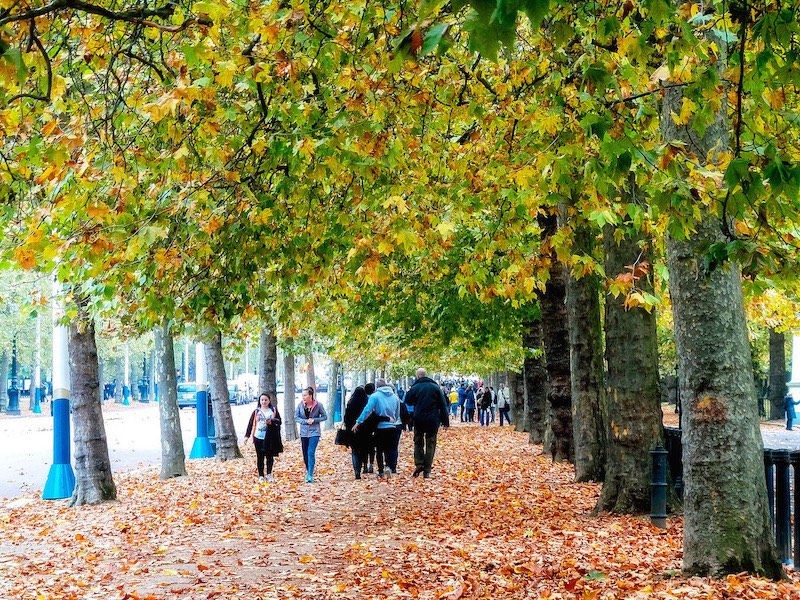
An ancient proverb says, “A society grows great when old men plant trees whose shade they know they shall never sit in.”
That’s really something when you think about it. In my opinion it’s the best reason to plant a tree. Even though you may benefit from the tree in your lifetime, your children and their children will get to enjoy that same tree’s shade, fruit, and beauty for generations to come.
Plus, if you live in Portland and plant a fruit tree, like an apple or fig tree, you can even contact the Portland Fruit Tree Project. They’ll come out and pick the fruit from your tree and provide it to people in need! What a great mission and one that’s easy to support. All you have to do is plant a tree!
When’s the Best Time to Plant a Tree?
People often ask me about the best time to plant a tree. My answer?
The best time to plant a tree is 5 years ago. The second-best time is today. By planting a tree today, you’re taking the first step towards reaping all the benefits of planting a tree that I talked about today. Planting a tree is an investment, and the sooner you invest, the sooner you’ll start seeing returns!
If you’re interested in planting a tree, contact me. I’m a certified arborist and can help you plant the perfect tree in your yard. Call (503) 538-8733 today and ask for a free consultation.
Photo Credits: Bill Reynolds, Garry Knight, Synspectrum, John Talbot, DanielSTL, Alexander Mueller,
Thursday, September 10th, 2015
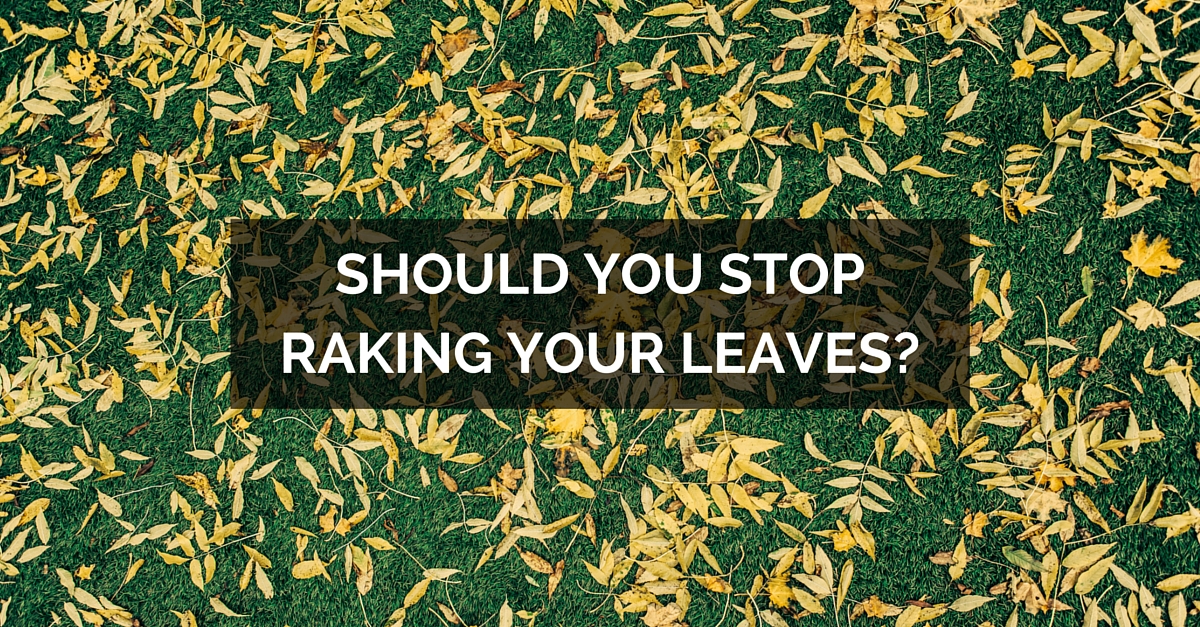
Having a big tree in your front yard is great… most of the time. Trees look nice, increase your home’s value, and provide shade, keeping your yard cooler in the summer. When fall comes around, it’s a different story.
Raking leaves is tiring, and keeping your property leaf-free can be a process lasting several months, depending on the tree. Most people don’t look forward to it. Maybe that’s why not raking the lawn is a growing trend.
Many people say it’s actually better for your lawn to not rake leaves. Are they right?
Pros and Cons of Raking Leaves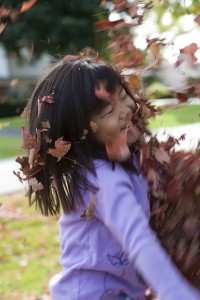
There’s good and bad on both sides.
For most people, the biggest benefit of raking leaves is the overall improvement to the appearance of their yard. Not to mention the fun of being able to jump into a freshly raked pile.
The biggest drawback for most homeowners is that it’s a lot of work. If you have a big yard and big trees, you may have to invest a couple of hours every weekend for a few months just to stay on top of it.
Other people say leaving a layer of fallen leaves suffocates the lawn and kills the grass. There’s quite a bit of evidence to the contrary, but if you really want to do what’s best for your lawn, you probably have better options than simply leaving your leaves untouched.
What Should You Do With Your Leaves?
Whether or not you rake your leaves really depends on a variety of factors, like where you live, how much work you want to put into leaf-control, and what you want your yard to look like.
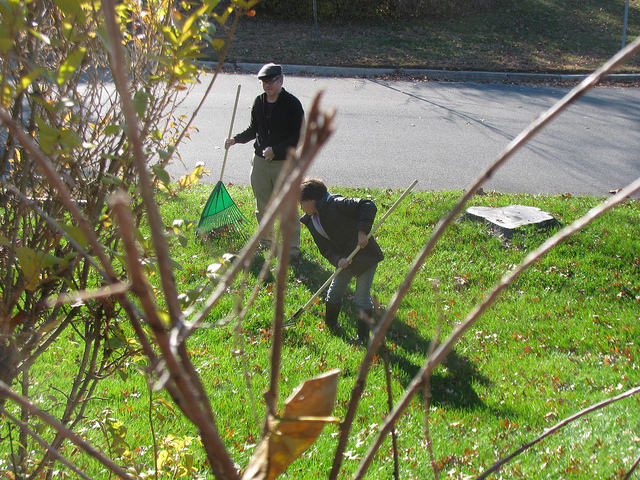
Here are a few options to consider:
Leave Them Alone
Leaving fallen leaves usually won’t damage your lawn — unless you have a LOT of leaves or you get heavy snow in the winter where you live. That might stop your lawn from getting the natural light and fresh air it needs to survive.
For most people, leaving leaves alone is a viable option.
Some neighborhood associations may want you to remove all your leaves to keep your lawn looking pristine. If that’s your situation, keep reading.
Compost Them
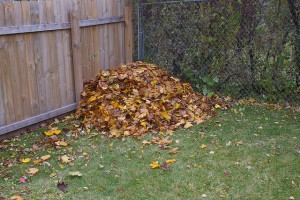 Did you know that even fallen leaves contain important minerals that are great for your soil and other plants? When you compost your leaves, you can get a healthier yard and find a use for all those leaves that would otherwise go to waste!
Did you know that even fallen leaves contain important minerals that are great for your soil and other plants? When you compost your leaves, you can get a healthier yard and find a use for all those leaves that would otherwise go to waste!
Want to try it?
Use a lawn sweeper or rake leaves into a pile somewhere out of the way, like the backyard. If you’re fine having the pile their for a while, you’re done! But if you want to encourage leaves to break down a little faster, try one of these tips:
- Grind or shred your leaves.
- Mix leaves with manure or another nitrogen rich material.
- Turn the heap regularly — anywhere from every 3 weeks to every 3 days.
Turning leaves more often encourages them to break down faster.
For more composting tips and the best way to grind your leaves, check out this article from compostguide.com.
Once the leaves are broken down you can use them as mulch for your lawn. It’s great for grass and other plants!
Leaf Pick Up
Many cities have programs for collecting leaves. The city will compost them for you! In Portland, where we’re located, leaf day pickups happen from early November to mid-December.
If you’re in Portland, you can participate in a leaf day pickup by checking what day the leaf truck will come through your neighborhood. You can find that out on their website when it gets closer to leaf pickup time, or call (503-865-5323) or email the city.
Before your pickup day, rake or sweep your leaves into the street 12 inches from the curb and make sure you move your car. Here are some other recommendations from the City of Portland.
Don’t live in Portland? Check your city’s official website to find out if your area has a yearly leaf pickup.
What if it’s Rainy?
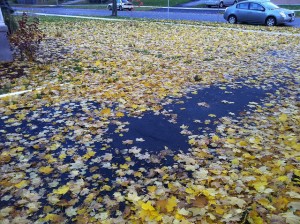 Here in Portland, rain in the fall is pretty common. Unfortunately. that makes it much harder to do anything useful with your leaves. The good news is heavy rain might make your leaves naturally biodegrade faster.
Here in Portland, rain in the fall is pretty common. Unfortunately. that makes it much harder to do anything useful with your leaves. The good news is heavy rain might make your leaves naturally biodegrade faster.
Even if you do plan to eventually rake or compost them, it’s fine to leave them until they dry out a bit.
Soggy leaves can be slippery, though. So try to at least get them off paths, sidewalks, and driveways. You can try using a rake or even a shovel with a flat head like a scoop shovel or a scraper.
What About Leaf Blowing?
Leaf blowing is great for moving dry leaves off paths, driveways, and sidewalk quickly and easily. It that’s all you want to do, it might be worth investing in a leaf blower.
The thing about leaf blowers is they just move leaves around rather than getting rid of them. They’re less precise than a rake or lawn sweeper, so they’re not great for getting leaves exactly where you want them, like in a pile.
If you want to actually get rid of leaves or compost them, you’re better off with a good rake or lawn sweeper and maybe a shovel to get leaves off concrete and asphalt.
Conclusion
I hope this post helped you find the best method for dealing with your fallen leaves this year. Regular tree pruning can reduce the number of leaves you have to deal with. If you want some free pruning advice give us a call at (503) 538-8733.
Do you have other solutions for dealing with leaves in the fall? Share them in the comments!
Photos: Andy Eick, Eden, Janine and Jim, Jeremy Noble, Derek Hatfield
Friday, August 22nd, 2014
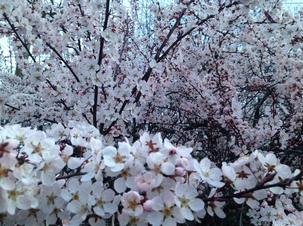 Planting trees is a fun and easy activity to do with your friends and family. When you plant trees on your property, you can add a lot of beauty and value to your landscape. While planting a tree can seem like a very simple task, there are many rules that you need to follow to ensure that your tree and landscape thrives.
Planting trees is a fun and easy activity to do with your friends and family. When you plant trees on your property, you can add a lot of beauty and value to your landscape. While planting a tree can seem like a very simple task, there are many rules that you need to follow to ensure that your tree and landscape thrives.
Read this post to learn how to properly plant a tree so that it can grow and stay healthy for years to come.
Research and Placement
Always research the type of tree that you would like to plant before planting. Different species can grow to unwanted sizes, send out roots that damage concrete and landscaping, or drop leaves and needles that damage roofs and patios.
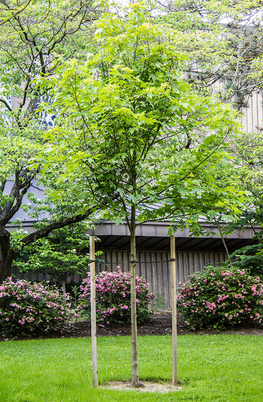 When choosing where to plant your new tree, there are several things to consider. First, make sure that your tree will not be placed too close to your home’s foundation or concrete structures. Generally, a space of 10 feet or more should be between any structure and your tree. Also, make sure to check with your State Utility Center to make sure that you won’t accidentally sever any dangerous electrical or water pipes on your property.
When choosing where to plant your new tree, there are several things to consider. First, make sure that your tree will not be placed too close to your home’s foundation or concrete structures. Generally, a space of 10 feet or more should be between any structure and your tree. Also, make sure to check with your State Utility Center to make sure that you won’t accidentally sever any dangerous electrical or water pipes on your property.
Consult your local nursery or arborist if you ever have questions about which type of tree to buy and where on your property to place it.
When To Plant
Different types of trees prefer to be planted throughout different seasons. Generally trees should be planted early or in the middle of spring or early to mid-fall. Avoid planting trees during the middle of summer because the heat and dryness can stress and kill a young tree.
Digging Your Hole
The depth and width of your hole is very important. If a tree is planted too deeply, the roots will have trouble absorbing oxygen and water through the top layers of soil. If a hole isn’t wide enough, the soil around the root ball will be too compacted to facilitate root growth.
Dig your hole at least 3-4 times as wide as the root ball of the tree. The depth of the hole should be slightly less than the height of the root ball. The ‘flare’ or collar of the tree where the base of the trunk begins to widen into the root structure should eventually sit just above the level of soil after the tree is fully planted.
Make sure not to compact the soil around the edges and bottom of your hole. Even using your shovel to loosen the surrounding dirt can assist the flow of water and root growth for your new tree.
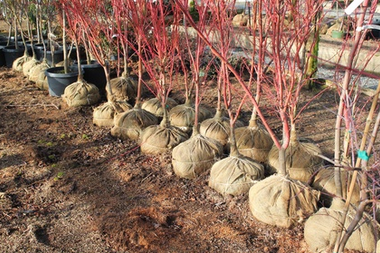 Removing the Container
Removing the Container
When you’re removing the tree from the container, be gentle but firm. Do not to pull the tree out by the trunk as this can hurt the entire root structure of the tree. Lay the tree on its side and tap and squeeze the container to loosen the soil. Gently slide the container off of the root ball of the tree. Cutting the container on both sides with a short blade (1-2 inches) can also help the removal process.
Separating the Roots
Depending upon how your tree was grown and how old it is, the roots may have formed to the shape of the burlap or plastic container. It is crucial that the roots of the young tree are not curling, twisted in circles, or bound around the tree. These types of roots will eventually expand and twist around themselves, essentially strangling or ‘girdling’ the roots of the tree and slowly killing it.
If the roots look ‘pot bound’ and twisted, use a short razor knife (1-2 inches) to make 4-6 cuts down the side and several cuts on the bottom of the root ball. This will cut and loosen twisted roots and force the tree to send out new roots in all directions helping it create an even and widespread root base.
Also, make sure to remove any stakes, ropes, and burlap from the tree before planting. These will inhibit root and tree growth.
Placing the Tree
Once the tree is prepared, place it in the center of your hole. Now is the time to align the branches and ‘pretty’ side of the tree to the main view point before you have fully planted it. Adjust the tree by the root ball, not by holding the trunk.
Make sure the top inch of the root ball is above the soil level and exposed. Place soil under the tree to slightly raise the level if needed. Once the root ball is in position use the soil you removed to fill in your hole. If your soil is mainly clay or particularly low-quality, you can use organic compost and other soil amenders to improve the quality. Avoid using heavy fertilizers and chemicals that can burn or kill a young tree.
After the hole is completely filled in, lightly tamp down the soil around the roots to stabilize the tree.
Creating a Berm and Mulching
 Creating a water basin or berm around the base of your tree will fight soil erosion and hold water where the roots can absorb it. Make a 3 foot diameter circular berm about 3 inches tall around your tree. Make sure not to cover the trunk or flare of the tree.
Creating a water basin or berm around the base of your tree will fight soil erosion and hold water where the roots can absorb it. Make a 3 foot diameter circular berm about 3 inches tall around your tree. Make sure not to cover the trunk or flare of the tree.
Once you have created the berm, cover the entire planting area with 3-4 inches of mulch. Taking care to keep the mulch at least 2 inches from the trunk of the tree. Read our previous post for proper mulching techniques.
Watering
Finally you will want to water your newly planted tree. Give your tree about 5-10 gallons of water to begin with to help settle the soil and stimulate root growth. Water your tree daily for about two weeks and then every other day for about two months. Eventually you can water your tree once a week until it is completely established.
Now that you have successfully planted your tree, make sure to water, prune, and care for it properly throughout its entire life. Spending several hours a month caring for your tree will ensure that you have a healthy tree that will give add shade and beauty to your home.
If you ever have any questions or concerns about planting a tree, don’t hesitate to contact your local arborist or the professionals at Northwest Arbor-Culture Inc. We have over 30 years of experience caring for trees and landscapes and can help you with any tree care need.
Have you ever planted a tree? Tell us about your experience in the comments section.







































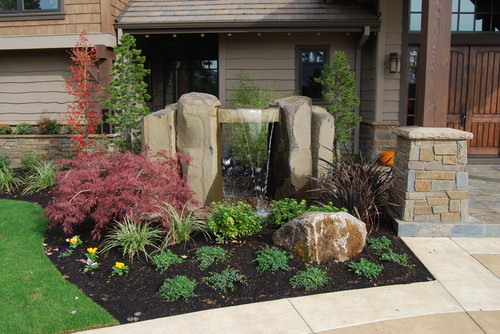
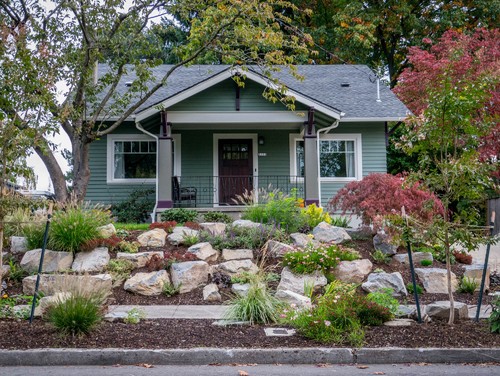
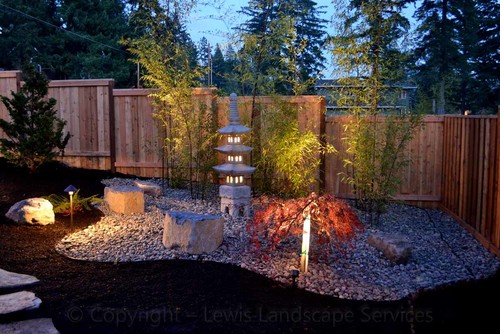


















 Did you know that even fallen leaves contain important minerals that are great for your soil and other plants? When you compost your leaves, you can get a healthier yard and find a use for all those leaves that would otherwise go to waste!
Did you know that even fallen leaves contain important minerals that are great for your soil and other plants? When you compost your leaves, you can get a healthier yard and find a use for all those leaves that would otherwise go to waste!  Here in Portland, rain in the fall is pretty common. Unfortunately. that makes it much harder to do anything useful with your leaves. The good news is heavy rain might make your leaves naturally biodegrade faster.
Here in Portland, rain in the fall is pretty common. Unfortunately. that makes it much harder to do anything useful with your leaves. The good news is heavy rain might make your leaves naturally biodegrade faster.  Planting trees is a fun and easy activity to do with your friends and family. When you plant trees on your property, you can add a lot of beauty and value to your landscape. While planting a tree can seem like a very simple task, there are many rules that you need to follow to ensure that your tree and landscape thrives.
Planting trees is a fun and easy activity to do with your friends and family. When you plant trees on your property, you can add a lot of beauty and value to your landscape. While planting a tree can seem like a very simple task, there are many rules that you need to follow to ensure that your tree and landscape thrives. When choosing where to plant your new tree, there are several things to consider. First, make sure that your tree will not be placed too close to your home’s foundation or concrete structures. Generally, a space of 10 feet or more should be between any structure and your tree. Also, make sure to check with your
When choosing where to plant your new tree, there are several things to consider. First, make sure that your tree will not be placed too close to your home’s foundation or concrete structures. Generally, a space of 10 feet or more should be between any structure and your tree. Also, make sure to check with your  Removing the Container
Removing the Container Creating a water basin or berm around the base of your tree will fight soil erosion and hold water where the roots can absorb it. Make a 3 foot diameter circular berm about 3 inches tall around your tree. Make sure not to cover the trunk or flare of the tree.
Creating a water basin or berm around the base of your tree will fight soil erosion and hold water where the roots can absorb it. Make a 3 foot diameter circular berm about 3 inches tall around your tree. Make sure not to cover the trunk or flare of the tree.
